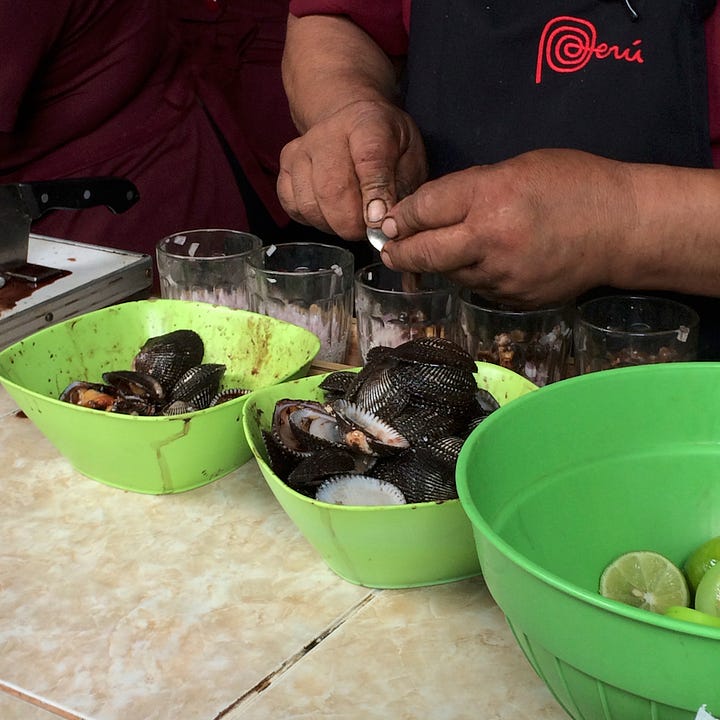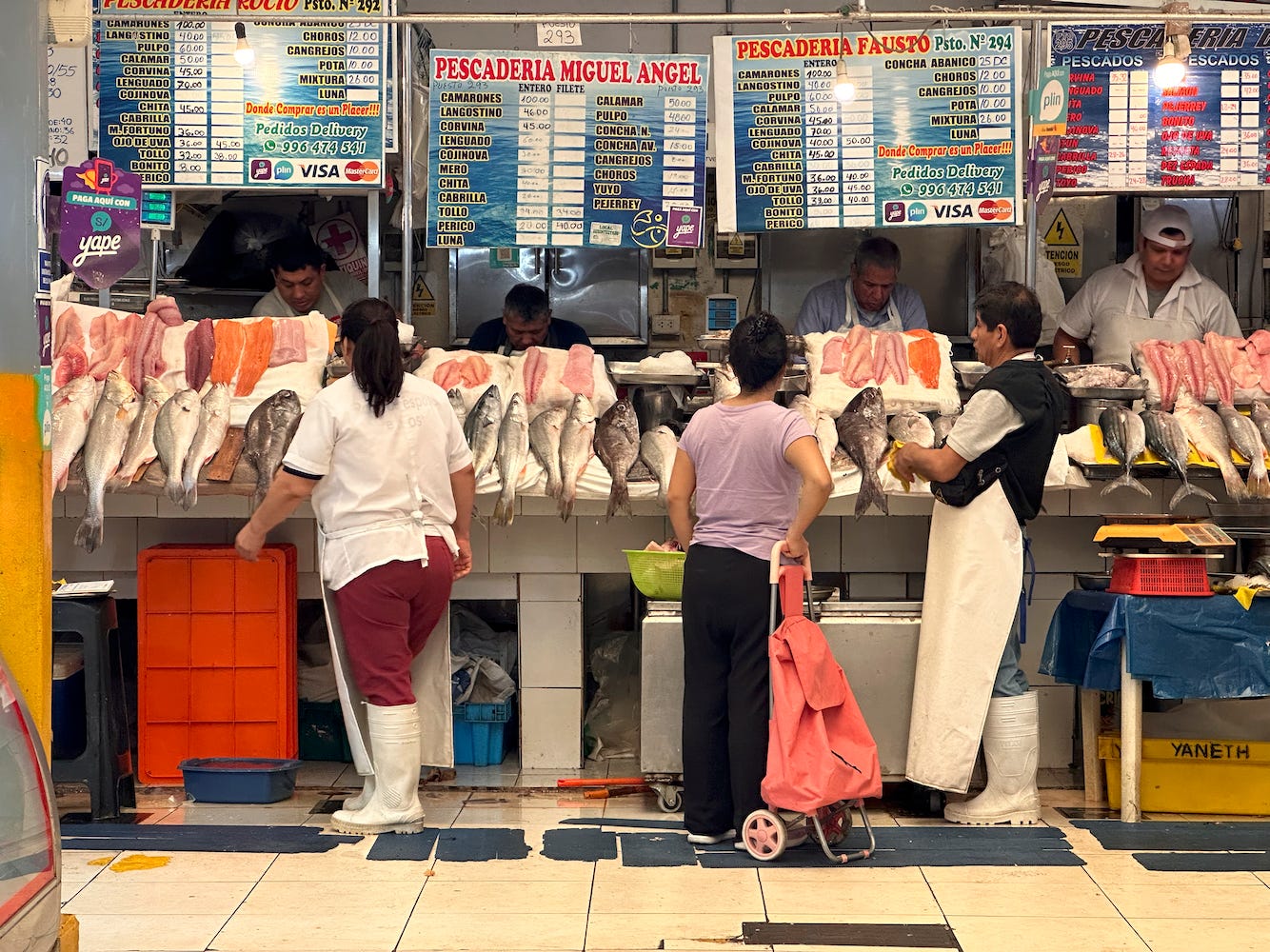Making Sense of Lima's Food Scene
Finding a food paradise within the concrete jungle
For me, Lima used to be a layover, but now it’s home. To fly between almost any two points in Peru, you have to fly to Lima first. The first half dozen times that I visited Lima was on the way to somewhere else.
During my first trip, I visited places in my trusty guidebook. Then, over subsequent trips, I gradually visited places further and further off the beaten path. This is the story of how I’ve gotten to know Lima better over the last six years.
First Impressions


For my first several trips, I would visit Lima with a different friend each time and we’d just take Uber to each place. I have a lot of great memories of discovering various aspects of Lima for the first time
… my friends taking me to La Punta in Callao during a long layover …
… walking seven miles from San Miguel to Surquillo to try ceviche …
… seeing Larcomar, a mall set on the cliffs of Costa Verde, suddenly seeming to emerge ...
… running into Huaca Pucllana, ruins in the middle of Miraflores, for the first time …
… Mariela and my first dates which took us all over Lima including multiple fish markets…
… watching the parasailers from the Malecon as the sun sets …
… our walks to San Isidro’s Bosque El Olivar …
Despite the initial memories, for the longest time, I was afraid of getting too close to Lima. Many people in Cusco would tell me how dangerous Lima was. I’m still not if these stories were just the stories people from small towns regale to bigger cities or if they were based on memories of what Lima was like in the nineties or whether I’ve just gotten used to a baseline level of danger from living in the mid-southside of Chicago and San Francisco.

Once I got to know Lima, I realized that there was a lot that people weren’t telling me. They didn’t tell me how beautiful the malecón is and how virtually undeveloped Costa Verde was (compare this to other tacky waterfronts around the world). I was also struck by how modern Lima was. It’s almost the main place in Peru with reliable internet and is accessible to the Amazon, Andes, and beaches of the Northern Coast less than two hours by plane. On a trip back from Cusco, I started seeing a semblance of a plan to find a foothold in Lima. It would take two more years and a pandemic for me to put this plan in action.
Staying for a While
Once I realized that I was staying a while, I wanted to better understand how everything was connected. I don’t really mean geographically understanding Lima. I’m not the person to go to for geographical advice; it’s embarrassing how many trips it took for me to realize that San Isidro is north of Miraflores.
I simply wanted to be able to tell a story about the food in Lima, the kind of personal perspective you’d offer to a friend who’s visiting. After my first few trips to Lima, I could rattle off a bunch of facts about food in Lima, but they didn’t fit together.
Hopping around different Airbnbs in Lima was a crucial transition point from being a visitor to more of a resident. For my first few months in Lima, I stayed in an Airbnb in a different neighborhood each month. For lunch, we would go to a different cevichería every day. By the time we went to every cevichería within a 15-minute walk, it would be time to pack everything up and head to the next neighborhood.
We discovered many small places that we wouldn’t have discovered otherwise. For me, the best way to discover new places is to walk by them multiple times until curiosity sets in.

Spending a couple of months helped me to better appreciate Miraflores. Some tourists choose to stay within the safe confines of Miraflores for their entire stay. I however previously avoided the center of Miraflores when I could because of a couple of not-great experiences. Staying in Miraflores, we were able to discover the quieter, less-hyped spots that we would’ve overlooked otherwise.
For me, food is the central thread to understanding places. I remember streets by the places where I’ve had ceviche. After staying in different Airbnbs, there were a lot more streets where I’ve had ceviche and where we would take late afternoon walks. I started being able to sense how far we were from the coast from various points and noticing the inflection points where one neighborhood changes into another.
Pulling on the Right Threads

I’ve found that just about every neighborhood can draw you in once you tug on the right thread. For example, my friends once took me to a bustling anticuchos place in Pueblo Libre, telling me never to go there alone. Then, Mariela and I started making Antiguo Taberna Queirolo one of our staples. Over the last couple of months, more of more of my “research” to led us to Pueblo Libre. I don’t think my friends’ original recommendation to be careful was wrong. It’s still not somewhere I’d wander around at night, but now it’s now one of our go-to neighborhood for a weekend lunch.
Like in every city, things constantly shift and evolve. My perspective is also constantly evolving. I’m sure some of the residents in Pueblo Libre would tell me something to the effect of “the best food was always here.” Limeneans always seem to be able to keep multiple truths in their head. They tend to think their neighborhood has the best food but are also will be quick to tell you about the many crises that their neighborhood currently faces.
For a while, Lima’s food scene was a mental Gordian knot that just got bigger and bigger. Then, I started following individual threads whether it was a particular restaurant or a type of dish. Some of these threads have taken me all over Lima. By following these threads, I started seeing patterns which helps me appreciate how things fit together1.
I’m now re-writing the Lima chapter of my guidebook. I’ve now spent more time in Lima than anywhere else in Peru yet this chapter gets harder to write as I peel more layers. How do you summarize a city like Lima? Many articles tend to take the easy approach of just summarizing the neighborhoods of Miraflores and Barranco. However, I wanted to see if I could push follower travelers (and myself) to dig a little deeper.
Next time, I offer three perspectives from which to explore Lima’s diverse food scene. Please subscribe so that you can be one of the first to get this and other stories about food around Peru.
P.S. I didn’t realize that conchas negras were such a big part of my journey until I placed the photos for this story. I guess conchas negras may lead you to doing crazy things like move to another continent!
I don’t mean to imply that Lima snaps together perfectly like pieces in a puzzle. I’ve now spent enough to realize that certain things won’t ever make sense. I used to chalk it up to my lack of Spanish fluency. Now, even when Mariela who is a native speaker is beside me, we still can’t make sense of certain situations. We’ve just learned to roll with it.



